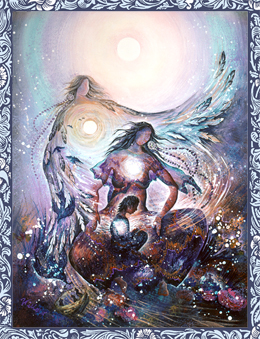I am sometimes asked what the ARCHETYPAL part of Archetypal energy Psychotherapy is, so I would like to address that question here. An archetype is a prototype, a broad brush stroke of an energy pattern or being. Some common archetypes are the mother, father, child, warrior, wholeness, higher self or wise sage, defensive parts or the mystic center. It is important to differentiate between the archetype and the symbol of the archetype. Take for example the archetype of the mother. Some ancient cultures have symbolized the energy of the nurturing mother as a cow. In Alaska, however, the native peoples there used the symbol of a whale to represent the mother. Same archetype, different symbol.
In Archetypal Energy Psychotherapy healing archetypes are sometimes invoked, or spontaneously appear. Let me give you an example from a session I did many years ago. My client was struggling with the fact that her father appeared to be rejecting her, and her mother was cold and un-nurturing. These two issues made it very difficult to come out and function in the world. She was often so angry about the situation that she would scream at the people she loved, pushing them away. She also disclosed that she almost died as an infant because she couldn’t absorb her mother’s emotionally toxic milk. We explored the issues, recalling old memories and allowing for emotional release. The client feared that the father was pushing her right out of existence, and she would die. I guided her into the sensations in her body and energy field, and then a series of images unfolded.
The client saw herself about 3 years old, riding a tricycle right toward “the void”. She was very afraid of disappearing, but I encouraged her to go into the void and see what was there. As she approached the portal to the void, she got smaller and smaller, until she disappeared through the portal. Immediately she found herself in the body of the great cosmic mother. She was held and nurtured there, as a fetus in the womb. Then the mother began extracting little dark pearls of toxins from her body, and replacing them with pearls of light and love. I guided the client to sense into her body and really absorb the love into her very cells.
In the next image, the client saw herself in a teepee. She was a newborn baby being lovingly mothered. Time went by, and soon she was ready to explore the world a bit. As she crawled out the teepee door, an archetypal father was waiting there for her. He appeared as a Native American, strong yet gentle. He took her hand and helped her walk. I guided my client to see if that being had an identifying name, so she could call on him again. His name was Speechwalker. We were both a little puzzled but then the client realized that this archetypal father was here to help her learn to speak more skillfully, and walk into the world!
Research in the field of neuro-science reveals that there is no difference to the brain between visualizing something and physically experiencing it. By accessing the archetypes of the nurturing mother and helpful father, my client was building new, wholesome neural-pathways in her brain. She was repairing the damage by her dysfunctional family of origin. I encouraged her to visit this archetypal mother and father often, to fully resculpt her brain and eventually heal her mother and father wounds.

